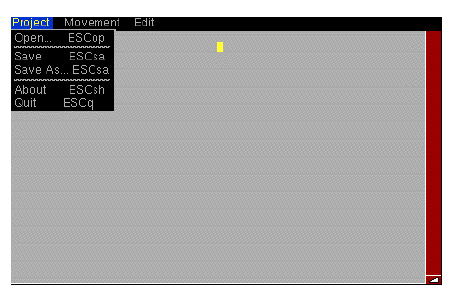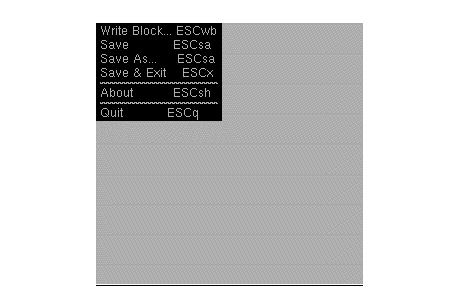
Any characters typed in immediate mode are inserted at the current cursor position and the cursor is shifted to the right. Any characters to the right of the cursor are shifted to make room for new text. If the line is wider than the width of the window, the window scrolls to the right to show what you are typing. If you move the cursor beyond the end of the line, ED inserts spaces between the end of the line and any new characters inserted.
There is maximum limit of 255 characters in a line. If you add more characters, ED displays a Line Too Long message.
To split the current line at the cursor, press Return. Any text to the left of the cursor remains on the original line. All text under and to the right of the cursor moves down onto a new line. Pressing Return at the end of the line creates a new blank line.

ED has no type over mode. To replace a word or line, you must delete the existing words and insert new information with the following keys and key combinations:
When text is deleted, any characters remaining on the line shift to the left and any text beyond the right edge of the screen becomes visible.

You can change the case of text by positioning the cursor and pressing Ctrl+F. If the letter is lower case, it becomes upper case and vice versa. Ctrl+F does not change non-alphabetic characters or symbols.
After you press Ctrl+F, the cursor moves to the right. You can hold down Ctrl+F to repeat the command until you change all the letters on the line.

In extended mode, commands are displayed on the command line - or status line - at the bottom of the window. ED does not execute these commands until you press Return or Esc. If you use Esc to execute extended commands, ED remains in extended mode. If you use Return to execute extended commands, ED returns to immediate mode.
Extended commands manage the following:
To enter extended mode, press Esc. An asterisk appears as a prompt in the status line. Extended commands consist of one or two characters. Multiple extended commands can be typed on a single command line by separating them with a semicolon. Commands can be grouped together for ED to repeat automatically. Use Backspace to correct mistakes.
You can also execute commands through the programmable menu and function keys. Reconfigure the menus and functions keys by assigning a command to the key or menu item of your choice as described on page 4-21.

In some cases, commands require arguments, such as a number or a text strig. A string argument for an ED command must be enclosed in a pair of identical delimiter characters. In unambiguous situations you may omit the trailing delimiter. Valid delimiters include ", /, \, !, :, +, -, and %. You cannot use the same delimiter character inside your string. Invalid delimiter characters include letters, numbers, spaces, semicolons, question marks, brackets, and control characters.

You can also ask ED to use a file requester, allowing you to view the contents of the drives and directories in your system.
To invoke a file requester for a load or save command, you must place a question mark (?) before the required string argument. Be sure to include a space before the question mark (for example, sa ?/Text/). Normally, when a command is followed by a string. ED treats the string as the file to be loaded or saved and attempts the operation immediately. However, the question mark indicates that you want to specify the file through a file requester. You must still specify a string after the question mark, but the string becomes the text that appears in the file requester title bar.

ED has two sets of command menu assignments: default and expanded. The default menu assignments, as illustrated in Figure 4-2, are set up by the S:Ed-startup file, which is automatically executed each time you run ED. The S:Ed-startup file is a command file of ED extended mode commands, without the Escape characters. You can edit this file to set up custom menus, as described on page 4-21, or define preprogrammed function key assignments with the Set FN Key menu item.

Figure 4-2. Default Menu Assignments

The expanded command menu assignments, as illustrated in Figure 4-3, can be enabled by renaming or deleting the default S:Ed-startup file. If ED cannot find a file named S:Ed-startup, it opens with the expanded set of menus, providing more options.

Figure 4-3. Expanded Menu Assignments
Rather then deleting your S-Ed-startup file, we recommend that you rename it as follows:
You can also create your own customized file of startup options. Avoid including Quit commands in the S:Ed-startup file since they can cause ED to quit immediately after opening.
The menu items in both the default and expanded menus have the same function regardless of which set you use. All of the ED commands are available through the keyboard using extended mode commands even if they do not appear in any menu.
The following sections describe the menu items found in the expanded menus and their corresponding extended and immediate mode commands. An ellipsis (...) indicates that an argument is required or that a menu item opens a requester or prompt.

The following are the expanded Project menu items:
